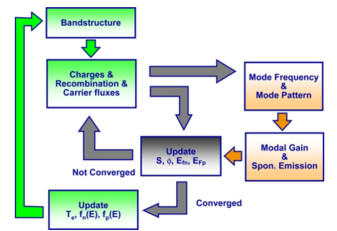Georgia Tech developers have leveraged recent developments in Metal Organic Chemical Vapor Deposition with their invention to address issues around transportation of minority and majority electric charges (i.e. holes and electrons) in HBT devices. Improvement in the transport of holes and electrons in the base region of the HBT devices made with InAl(Ga)N/(In)GaN (In-Indium, Al–Aluminum, Ga– Gallium, N–Nitride) short period super-lattices are demonstrated by the results. The design enables reduced hole concentration in the base layer of the HBT, while simultaneously increasing emitter injection efficiency and providing for highly linear operation of the device. The novel design helps provide an additional degree of freedom in device operation by using high-quality InAlN layers and InAlGaN quaternary materials. The approach also dramatically reduces series base resistance, increases switching speed and power amplification bandwidth, without compromising base transport factor and current gain through the introduction of electron traps.
- Low Resistance - Designs with zero offset in conduction band energy and sufficient discontinuity in valence band energy to ensure the high lateral conductivity required for low extrinsic base resistance
- High Conductivity - Simultaneous and substantial enhancement of lateral base conductivity as well as base transport factor in HBT devices
- Excellent Control - Excellent electrostatic control throughout the HBT’s base region with a remote base electrode by virtue of enhanced lateral conductivity
- Switches and Power Amplifiers for Power Grids, Electric Vehicles, Mass Transportation, etc.
- High-Efficiency Visible LEDs
Heterojunction Bipolar Transistors (HBT) are a semiconductor transistor often used in high-frequency communication devices like RF power amplifiers in cellular phones and high power efficiency devices like LED. An HBT consists of an emitter, base, and collector. When a voltage is applied to the base, electrons flow from emitter to collector. Dissimilar semiconductor materials used in HBT improve electron movement in the device and provide benefits like faster switching capability and higher operational frequencies. Current HBT architectures tend to be limited in performance features due to the weak electrical activation of certain elements, limiting the efficient modulation of both current and power. By using specially designed magnesium doped short period super-lattice structures, these limitations can be overcome and simultaneous and substantial enhancement of lateral base conductivity, as well as base transport factor, can be achieved.

